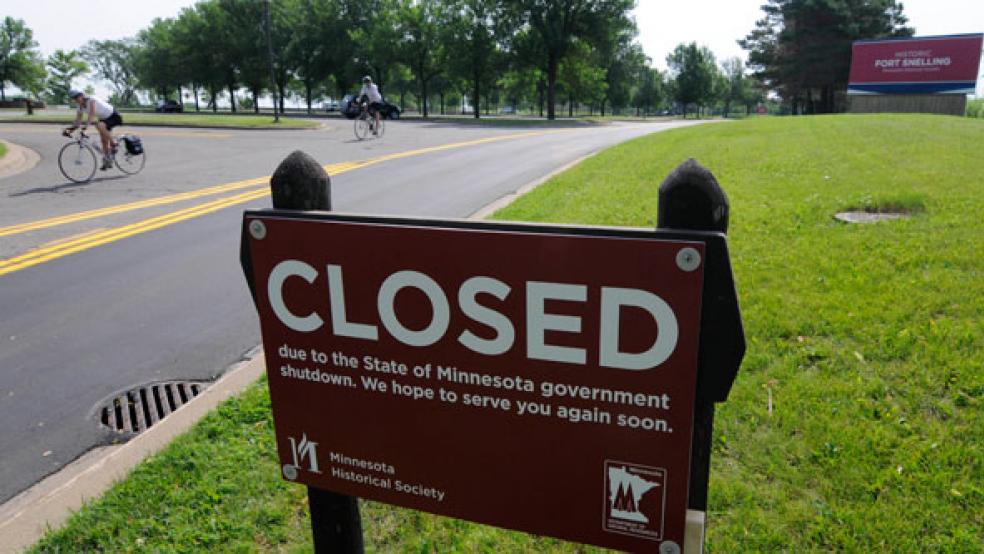As President Obama and Congress move unexpectedly toward another budget crisis tonight, it’s time to take stock of how a government shutdown would affect federal workers, the military, government contractors and average Americans reliant on government programs and benefits.
Congressional leaders insist that if efforts to pass a $1.1 trillion spending bill for the remainder of the fiscal year collapses Thursday night, Congress would pass a short-term extension to enable the government to limp along for another three months.
Related: Disarray on Capitol Hill as Cromnibus Stalls
But with so much uncertainty, the possibility of another government shutdown cannot be totally ruled out.
The last three government shutdowns – in late 2013, late 1995 and early 1996 – were chaotic for federal workers, posed major inconveniences for the public, and prompted a political backlash.
The dispute, this time, is over provisions in the omnibus spending bill. One provision weakens part of the Dodd-Frank Act, which regulates Wall Street Banks. The other measure increases substantially the amount an individual can contribute to a political party or PAC.
What’s ironic about the Democrats’ position is that President Obama has given the bill his blessing. But far left liberals in the House and Senate are standing firm. On the other side, far right conservatives are not approving the bill because they’re upset that nothing in the bill derails Obama’s executive action on immigration.
So here we go again - a dysfunctional Congress playing fast and loose with American lives.
Below are the nine most important things to keep in mind as the second government shutdown in two years approaches:
$41 million authorized for rape kit testing would be put on hold. Hundreds of thousands of municipal rape kits have never been tested. So Congress allocated the money to cover the $500 - $1000 cost for processing each kit. In just testing the first 2,000 kits, they identified 200 serial rapists. If the government shuts down, so will the testing.
$150 million a day. That’s the conservative price-tag to taxpayers for closing down the government. In 1995, the record three-week closing cost a $1.25 billion or $1.9 billion in today’s dollars.
Uncle Sam would limp along but not collapse. Many federal agencies are deemed essential to protect life and property, or to provide benefit payments. These agencies would be allowed to operate, although their workers could not draw a salary – at least not immediately.
In the past, that has meant that employees involved with border and coastal security, protection of federal lands and buildings, the care of prisoners, law enforcement and criminal investigations, emergency and disaster assistance, the Treasury and financial system and maintenance of the power grid, were all kept on.
But plenty of services would disappear. The last government shutdowns were grim times for federal workers, with about 800,000 being furloughed.
The Centers for Disease Control and Prevention halted disease surveillance. Toxic waste clean-up work at 609 sites was halted. And while zookeepers continued to feed the pandas, the National Zoo in Washington, D.C., was closed to the public. So was the Washington Monument, the Lincoln Memorial and 368 national park sites, which resulted in the loss of some seven million visitors.
With non-essential workers on furlough, 200,000 applications for passports went unprocessed. U.S. tourism and airline industries incurred millions of dollars in losses; and more than 20 percent of federal contracts, representing $3.7 billion in spending, were affected adversely.
Social security benefits would keep flowing. Social Security is a mandatory program that would continue during a shutdown, but the entire system would be gunked up. During the 1995 and 1996 shutdowns, claims from 112,000 Social Security applicants went unprocessed, 212,000 Social Security cards were not issued and 800,000 toll-free calls for information went unanswered.
You’d still get mail. The U.S. Postal Service is an independent agency and doesn’t directly receive revenues from the Treasury, so it will continue deliveries through sleet, snow, rain and government shutdowns.
Many federal employees and contractors would work for no pay. According to an OMB advisory memo to agencies last year employees who stay on the job would not get a paycheck at first. But they would be entitled to retroactive pay once the government is running again. This includes all military personnel.
The situation is much less clear regarding nonessential employees. They would have to come to the office on the first day of a shutdown to secure files, fill out time and attendance forms and “otherwise make preparations to preserve their work,” according to the OMB.
Contractors won’t get paid on time. Federal contractors would likely have to push back project deadlines, because the agencies that hired them wouldn’t be able to issue the necessary paperwork.
Garbage would pile up. Congress would heap one more indignity on the District of Columbia if there’s a shutdown. The city’s trash collectors would be furloughed, along with other D.C. workers whose operating budgets are approved by Congress. That’s going to be a messy situation, since D.C. produces about 500 tons of garbage each week, according to The Washington Post.
This is an update of an article that originally ran last year in The Fiscal Times.
Top Reads From The Fiscal Times:





